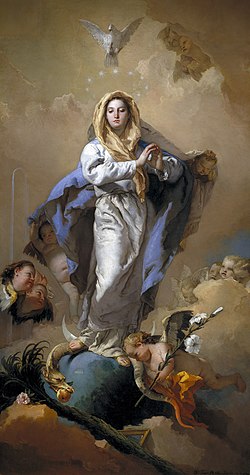
Back Onbevlekte Ontvangenis van Maria Afrikaans Purisma Concepción AN الحبل بلا دنس Arabic Imaculada Concepcion BCL নিষ্কলঙ্ক গর্ভাধান Bengali/Bangla Ar Werc'hez Vari koñsevet dinamm Breton Immaculada Concepció Catalan Neposkvrněné početí Panny Marie Czech Jomfru Marias ubesmittede undfangelse Danish Unbefleckte Empfängnis German
Our Lady of the Immaculate Conception | |
|---|---|
 | |
| Venerated in | Catholic Church Ethiopian Orthodox Tewahedo Church Eritrean Orthodox Tewahedo Church |
| Major shrine | Basilica of the National Shrine of the Immaculate Conception |
| Feast | December 8 (Latin liturgical rites) December 9 (Byzantine Rite) August 13 (Alexandrian Rite) |
| Attributes |
|
| Patronage | See Patronages of the Immaculate Conception |
| Part of a series on the |
| Mariology of the Catholic Church |
|---|
 |
|
|
The Immaculate Conception is the belief that the Virgin Mary was free of original sin from the moment of her conception.[1] It is one of the four Marian dogmas of the Catholic Church.[2] Debated by medieval theologians, it was not defined as a dogma until 1854,[3] by Pope Pius IX in the papal bull Ineffabilis Deus.[4] While the Immaculate Conception asserts Mary's freedom from original sin, the Council of Trent, held between 1545 and 1563, had previously affirmed her freedom from personal sin.[5]
The Immaculate Conception became a popular subject in literature,[6] but its abstract nature meant it was late in appearing as a subject in works of art.[7] The iconography of Our Lady of the Immaculate Conception shows Mary standing, with arms outstretched or hands clasped in prayer. The feast day of the Immaculate Conception is December 8.[8]
Many Protestant churches rejected the doctrine of the Immaculate Conception as unscriptural,[9] though some Anglicans accept it as a pious devotion.[10] Opinions on the Immaculate Conception in Oriental Orthodoxy are divided: Shenouda III, Pope of the Coptic Orthodox Church, opposed the teaching,[11] as did Patriarch Ignatius Zakka I of the Syriac Orthodox Church;[12] the Eritrean and Ethiopian Orthodox Tewahedo accept it.[13] It is not accepted by Eastern Orthodoxy due to differences in the understanding of original sin, although they do affirm Mary's purity and preservation from sin.[1] Patriarch Anthimus VII of Constantinople (1827–1913) characterized the dogma of the Immaculate Conception as a "Roman novelty".[14]
- ^ a b Tinsley 2005, p. 286.
- ^ Collinge 2012, p. 133.
- ^ Wright 1992, p. 237.
- ^ Collinge 2012, p. 209.
- ^ Fastiggi 2019, p. 455.
- ^ Twomey 2008, p. ix.
- ^ Hall 2018, p. 337.
- ^ Barrely 2014, p. 40.
- ^ Herringer 2019, p. 507.
- ^ "Immaculate Conception". An Episcopal Dictionary of the Church, A User Friendly Reference for Episcopalians. Retrieved May 3, 2022 – via Episcopal Church.
- ^ Shenouda III; Malaty, Tadros. "Lecture I: St. Mary's Perpetual Virginity & Immaculate Conception" (PDF). Diocese of the Southern United States. Retrieved May 16, 2022.
- ^ Ignatius Zakka I; Ghattas, Sandy. "The Holy Virgin Mary in the Syrian Orthodox Church". Syriac Orthodox Church of Antioch, Archdiocese for the Eastern United States. Retrieved December 17, 2023.
- ^ Cite error: The named reference
Eritreanwas invoked but never defined (see the help page). - ^ Meyendorff 1981, p. 90.
© MMXXIII Rich X Search. We shall prevail. All rights reserved. Rich X Search